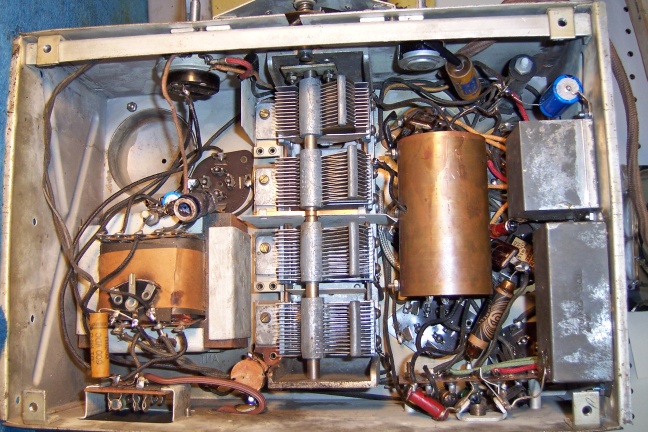Sparton Model 10 Radio Restoration (2nd)
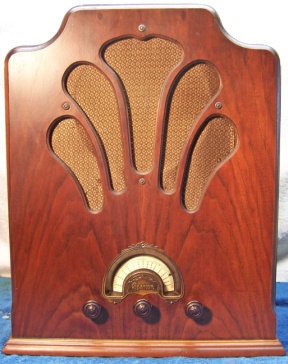 |
This is my second Sparton Model 10 restoration. The
first one I restored was sold. The Sparton Model 10 is an early 7-tube AC non-AVC
Superheterodyne radio, broadcast band only. The set features a
double-tuned pre-selector (four section tuning capacitor) with an RF
amplifier stage. It uses 2.5 volt tubes typical of the early to mid 1930's.
The radio had seen EXTENSIVE servicing and attempted restoration in the
past. I decided to attempt to reverse prior servicing and
restoration to the extent possible, yet restore operation..
The schematic for the radio can be found on Nostalgia
Air but it is hard to read and there are several errors. |
My
antique radio restoration logs
Condition as Found
The radio was purchased on eBay. As acquired, the cabinet, grille cloth and knobs were original and in
very good condition There was some loss of finish at the
top of the cabinet.
The veneer on the front was in excellent shape (the remainder of the
cabinet is solid wood). But the radio had
seen multiple electrical repairs in its past. The original nickel plated copper
Mershon filter capacitor had been removed and replaced by tubular
electrolytics clamp-mounted under the chassis. The volume and tone control had
been replaced - somewhat messily but with correct value parts. Both
original controls had the smaller 3/16" round shafts, and the replacement control
shafts had 1/4" shafts that had been very roughly filed down to fit the knobs! None of the tubes
were the original Sparton types (labeled 427, 435, 480 etc.) so all of the
tubes had been replaced sometime in the radio's life. A globe 45 was in
the 480 rectifier socket - and it was GOOD - so it is unlikely that anyone tried
plugging in the radio. All four tube shields were missing. This is
typical for this radio, since most of the shields (and thus the tubes) cannot be
removed or replaced unless the chassis is pulled or the speaker removed!
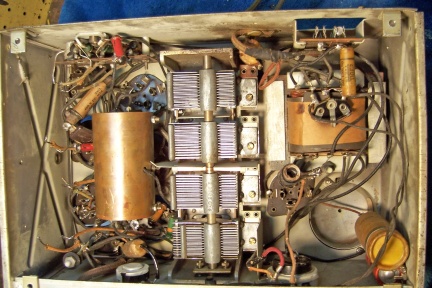
To make matters worse, an "old time collector" (per
the eBay listing) had
likely started restoration of the radio and then abandoned the project (or may
have died).
The two metal bypass capacitor blocks had been removed and their wire leads cut
flush with the capacitor cases and left
hanging! Luckily, the eBay seller went back to the location where the
radio was purchased (the "old time collector") and found a box labeled
"Sparton parts" - it contained the two missing metal bypass capacitor blocks, but
no other missing parts. Only two of the original paper capacitors remained - they had
been replaced in an older repair. All resistors were the original dogbone
(body-end-dot) types but with a stripe as the multiplier rather than the usual
dot.
Survey
My usual restoration procedure is to first make a complete
survey of the condition of all components before starting any repairs. The survey results guide my
restoration strategy. If major and unique components are defective and
cannot be restored or replaced, I may elect to sell the radio for parts rather than
to restore it.
I assume that all paper and electrolytic capacitors are leaky and thus should be
replaced (I always "restuff" the original containers if possible).
-
The antenna choke coil L11 was open and burned, likely due
to the antenna coming in contact with a power line or perhaps due to a lighting
strike. Fortunately the antenna coil itself was OK.
-
The line cord had several breaks and was not usable.
-
The detector plate choke was OK.
-
All RF and IF transformers were OK.
-
The power transformer was OK. The high voltage was
equal on both sides of the center tap, all windings measured the correct voltage,
and the wattage draw was very low - less than 10 watts at full line
voltage. My initial check is done at about 20 volts through a variac
in case there are shorted turns.
-
All power resistors were OK.
-
The speaker was OK and the field coil and output transformer
were good
-
All tubes were good, but were the wrong types in most cases
(they were originally the hard to find Sparton brand, but at least they should be globe
types).
-
Two dogbone resistors had drifted in value and were now out of
tolerance.
-
The hum balance resistor was intermittent
-
The AC power switch was intermittent and likely had dirty or
oxidized contacts (not original).
-
The volume and tone controls were intermittent (neither were
original)
-
A 10-amp fuse had been installed (1.5 amp is specified).
-
The pilot lamp was OK, but the leads to its socket were
frayed and could possibly short out.
Repairs
This is a very difficult radio to work on - one of the worst I have
encountered. The chassis is packed full, and components must be removed in
order to access components below them. The four gang tuning capacitor is
UNDER the chassis! The chassis has to be removed in
order to remove several of the tubes and tube shields. The chassis is
tethered to the speaker by a cable. The cable needs to be unsoldered from
the speaker terminal board before the chassis can be removed - no plug was used!
I had to remove the combination
first detector and oscillator coil (inside the copper shield under the chassis -
see under chassis photo above - and
the volume and tone controls in order to access and test components below them. The
two bypass block capacitors had already been removed, otherwise they also would
have had to be removed. The tuning capacitor plates were rubbing and
shorting out. I wanted to remove the capacitor in order to make
repairs. HOWEVER, I discovered that the two IF transformers as well as the
Antenna coil were attached to the top of the capacitor! So in order to
remove the capacitor, wiring to all of these coils would have to be disconnected
and the capacitor and coils removed as a unit! I managed to straighten the
plates with the capacitor in situ.
The bare areas of the original pilot lamp leads were insulated using
spaghetti tubing.
Antenna Choke
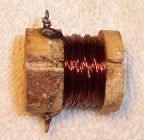 |
The antenna choke coil L11 was open. It is connected
between the antenna connection and the chassis and ground
connection. It showed signs of heating. I suspect that the
antenna must have contacted a power line rather than a lightning
strike. I unwound the extant wire (there were multiple breaks) and
counted turns. The wire was replaced with the correct number of
turns, but with a slightly large gauge magnet wire that I had in stock. |
Paper-Wax Capacitors
The radio contained only four tubular paper-wax type capacitors. As
found, there was a 0.01mfd line bypass capacitor installed from the common power
transformer lug to the chassis. This capacitor is NOT shown on the
schematic in Riders. But in a previous
restoration of this same radio, a 0.006mfd capacitor was installed, and it
appeared to be original. Most
capacitors in this radio were either mica or contained in two metal containers. The
original tubular paper-wax capacitors were made by Cornell (later to become Cornell-Dubilier?)
and branded "Cub". Only one original Dubilier Cub capacitor
remained - the rest had been replaced with newer units. Dubilier Cub
capacitors are quite unique in construction and cannot be re-stuffed in the conventional manner. Here
is the procedure I used to restore them. The results are shown below.
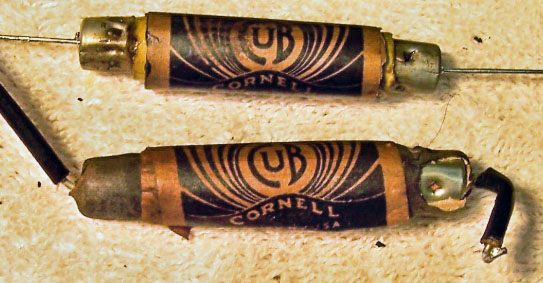 |
The capacitor on the bottom is an original Cub
capacitor. The capacitor on top is a reproduction using a new film
capacitor, while retaining the original label and end caps. |
Since I did not have any original Dubilier Cub capacitors in my dud capacitor
stock, the replacement capacitors found in the radio were instead restuffed with
new components.
Bypass Capacitor Blocks
Originally there were two metal case bypass capacitor blocks in this radio.
Both were stamped "Tung-Sol 8-31" (I did not realize that Tung-Sol
made capacitors!) One contained
three 0.5 mfd capacitors (one high voltage and two low voltage). The other
contained seven capacitors or either 0.2 or 0.3 mfd. Two were high voltage
and the remainder low voltage cathode or filament bypass capacitors. The
eBay seller was able to find the original bypass blocks that had been
removed. The original leads had been cut flush with the capacitors and
stripped - I suppose the "old time collector" was planning on
installing terminal strips in order to mount replacement capacitors. I
decided to restuff the originals instead - a much neater installation.
Unfortunately I would have to replace the lead wires.
The cases were opened by removing a cardboard cover and the contents removed
mechanically (they were originally sealed with a tar-like substance). The
capacitor block originally containing three 0.5 mfd capacitors was
rebuilt using a 0.47 mfd 630 volt axial film capacitor and two 0.47 mfd 400 volt radial film capacitors. The other capacitor was rebuilt
using seven 630 volt axial film capacitors of either 0.22 or 0.33 mfd. New wire leads were used in
both cases. This capacitor was filled with rosin in order to stabilize the contents,
and the cardboard covers reinstalled.
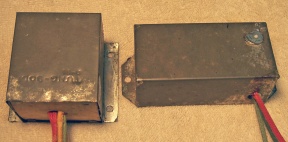
Mershon Filter Capacitor
The original nickel plated Mershon filter capacitor unfortunately had been
removed in a previous repair. It had been replaced by two tubular
electrolytic capacitors installed under the chassis. The capacitor was two sections: 8 and 16 mfd (voltage
unknown). The main part of the capacitor was below the chassis, secured by
a clamp. The terminals on top were covered by a clamped-on shield. Since
I did not have a suitable replacement, standard tubular electrolytics were used
(10mfd and 22mfd at 630 volts).
Resistors
There were two resistors that needed to be replaced. They were the old
style "dog bone" types. But these were unlike any that I had
seen before: instead of a color dot for a multiplier, these used a color
band. They were replaced using standard 1/2 watt carbon composition
resistors, but hidden inside spaghetti tubing. Due to their locations,
they would not be visible.
The adjustable hum control pot showed intermittent operation. Cleaning
the slider and resistance element restored normal operation.
Other Repairs
- The AC power switch was not functional. I removed the volume control
and sprayed in Big Bath cleaner. By rapidly operating the switch
the switch was OK (contact resistance less than 0.2 ohms). This also
restored correct operation of the volume control.
- The tone control was also cleaned using Big Bath cleaner.
Testing
After completion of restoration, the radio was connected through a watt meter
to a variac and the power gradually applied while monitoring the B+. A 50'
indoor antenna was connected. The radio immediately came alive and worked
well. The radio was then aligned. In order to adjust the IF transformers, the shields had to be
removed - there is no way to adjust the trimmers with the shields in place, and
if removed, the alignment is affected. The radio works very well with very good tone and sensitivity for an
early superhet.
Post Restoration Photos
Restored Chassis. The large copper cylinder is the combined mixer and
oscillator coil shield. The two metal boxes on the right are bypass
capacitor blocks.
